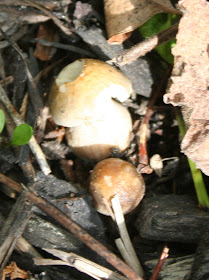I never go out to weed without first talking to the fairies. (For those of you who are now convinced that I've truly lost my mind, not to worry, my husband is a psychiatrist and there are days he would probably agree with you.)
Legend has it that rings or arcs of mushrooms known as fairy or faerie rings designate areas where fairies might be seen. Some legends hold that these represent entrances into the fairy world.
Whatever you think they represent mystically, from a purely scientific point of view they indicate the presence of the fungus mycelium growing underground in the soil in fairly complex, extensive networks.
The mushrooms you see on the surface are not individual plants that you can pluck and get rid of like :"regular" weeds. They are actually the fruit of the fungus that lies buried in the soil and their purpose is to produce and disperse spores of the fungus. They serve the same purpose as the blooms on any other plant. If you cut the blossoms, you still have the plant.
Actually, although they sprout from the soil like any other plant, mushrooms are not plants at all. They don't conduct photosynthesis or otherwise produce food for themselves or the fungi that spawn them. This is a good news/bad news kind of thing. It means that the fungus needs to get all of its nutrients from the soil. If these are showing up in your garden, they are competing for the same nutrients your plants are, and since they have hearty appetites, they can drain the soil of significant quantities of nutrients (especially nitrogen) in a hurry.
But they tend to show up where there is an adequate supply of food.... dung (including doggie doo doo), rotted stumps, or lots of compost, and in particular, when it has been very damp or rainy for several days. They usually indicate that decay is happening underground. That's a good thing, as the decay of organic matter (leaves, twigs, tree stumps) puts nutrients back into the soil. Where leaf and twig mulch is decaying into compost in a shady area of the garden is where we see them the most.
Here, a new fairy ring is just starting to develop. Over a month ago, we left a pile of twigs and leaves sitting on the mulch in the shade garden. It's been rainy and lousy and we haven't gotten around to collecting all the detritus to move it to the compost pile.
The small nubs that will eventually become mushrooms will be sprouting around it shortly. Although it's hard to see in the overall image, in addition to one that has started to stand on it's thinning stalk, small brown nubs can be seen all around the pile of twigs and leaves. Regrettably, I will be away this week for several days while it fully sprouts and will likely miss seeing a nearly perfect ring develop.
 |
| Close-up of the mushroom nubs that surround the brush pile |
 |
| Other segments of this same ring, photograph taken the next day |
 Once the mushrooms shed their spores, like any other seed pod in the garden, they dry up and die.
Once the mushrooms shed their spores, like any other seed pod in the garden, they dry up and die.I recommend wearing disposable latex gloves to handle mushrooms. Some folks (like me) are allergic to mushrooms and just handling them with my bare hands causes me to break out in hives and have difficulty breathing. And handling mushrooms that may be poisonous with your bare hands is also ill-advised. Since pets and children occasionally eat them and can become quite ill, removing them removes that temptation as well. But remember that the mycelium and its network remains underground and the mushrooms are likely to spring forth again after a damp or rainy spell.
But talk to the faeries when you do, and leave them a little gift in their place.... some tidbits of chocolate or a few little crystals or sparklies, or perhaps even a faery door. They will reward you by looking after your garden.
The above faery arc was part of a large - about 10 foot diameter - incomplete ring. We saw mushroom growth fairly consistently in various places around what would have likely been the perimeter of a fairly large oval ring. Although it was quite sparse in areas, it formed an essentially circular pattern when looked at from a whole. The newly forming ring pictured above is several feet away from this one but in the same general area. Both were associated with composting leaf and bark mulch and small leaf and brush piles from early spring clean-up that had not yet been moved to the compost area.









What an interesting post. I hate to see mushrooms springing up in the yard. I'll have to start looking for the ring!
ReplyDeleteThanks so much for stopping by!
ReplyDeleteHonestly, I hate to see them as well, but more as a practical matter. I am deathly allergic to them and have to use extreme care (latex gloves inside work gloves, then wash the work gloves, and keep adrenaline handy) if I have to work around them.
But the idea of faeries is tantalizing and sometimes being immersed in the garden is almost like living a fairy tale.... I so want to experience them! (Silly me!)